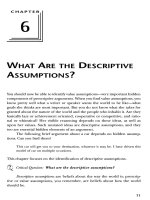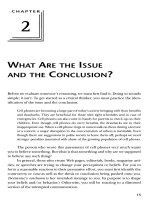These are the flowers for fragrances
Bạn đang xem bản rút gọn của tài liệu. Xem và tải ngay bản đầy đủ của tài liệu tại đây (20.14 KB, 1 trang )
These are the flowers for fragrances!
Specific Flower Fragrances
Although many flowers are fragrant, some flowers gained popularity because of their having exceptionally fragrances.
Some of those flowers with high fragrances, infact unique fragrances are dealt with here.
Rose:
One of the most valuable elements of a fine perfume is provided by the rose, known as the "queen of flowers". Rose
perfumes were very popular with the Romans and the Greeks. Rose flowers are gathered at night since they carry
fragrance before sunrise. The two main species of roses used in perfume are the Rosa centifolia, found in the South of
France, and the rosa damascena (Damask Rose) located primarily in Arab countries. The damask rose is most widely
grown for perfumery.
Jasmine:
Jasmine, another "absolute," or pure essence, gives a perfume a well-rounded, finished quality. Jasmine flowers are
harvested when their fragrance is at its peak just before dawn. The flowers must be processed immediately before their
freshness and fragrances fade away. The jasmine must also be placed in special baskets to prevent the flowers from
bruising, and unbalancing the flower's natural bouquet.
Violets:
Violets have been used in perfumes throughout the ages because of their varied fragrances. They used violets in both
perfumes and medicines. There are two varieties of violets most commonly used in perfumes, the Victoria Violet and the
Parma Violet. Violets only produce a scant amount of essential oils, and are rarely used today. A synthetic replacement
for violet is most commonly used, along with other essential oils resembling the violet.
Lily:
The Lily (Lillium) is a hearty bulb that can be planted in fall or spring. In the whole lily spectrum, there is something for
everyone, from easy-to-grow, long-lived garden plants to the more difficult and rare species. Their summer blooms are
the highlight of the garden, and they are long-lasting as cut flowers. Most lilies bloom between June and August, and the
large, trumpet shaped flowers feature a variety of colors, designs and fragrances.
Orange flower:
The orange flower is the traditional flower of brides all over the world, essentially because of its fragrance. Orange flower
is one of the most versatiles producing essential oils for this scent. Its blossoms provide orange flower absolute. Orange
flower oil or "neroli" was named after the Italian Princess of Neroli. She began the fashion of using the oil for scented
gloves. Oil of "petit grain" is obtained by distillation from the leaves and twigs. Orange flowers are grown in the south of
France, Spain, Italy and North Africa.
Ylang-ylang:
Ylang-ylang is widely used for fine fragrance. This flower is found throughout South-East Asia. The ylang-ylang is not
picked until the buds have been open for two to three weeks. After they have been gathered, they must be processed
quickly. This oil is commonly used, but synthetic versions, and cananga oil is often substituted in less expensive
perfumes.
Plumerias:
Plumerias are beautiful and fragrant trees. Their flowers are used to make the Hawaian leis. These flowers are treasured
by the Polynesian Islanders for their durability, fragrances and colors of whites, yellows, pinks, reds, and multiple pastels.
Flowering can last up to 3 months at a time producing new blooms everyday. Once picked, a bloom can last for several
days without wilting if kept in water.









